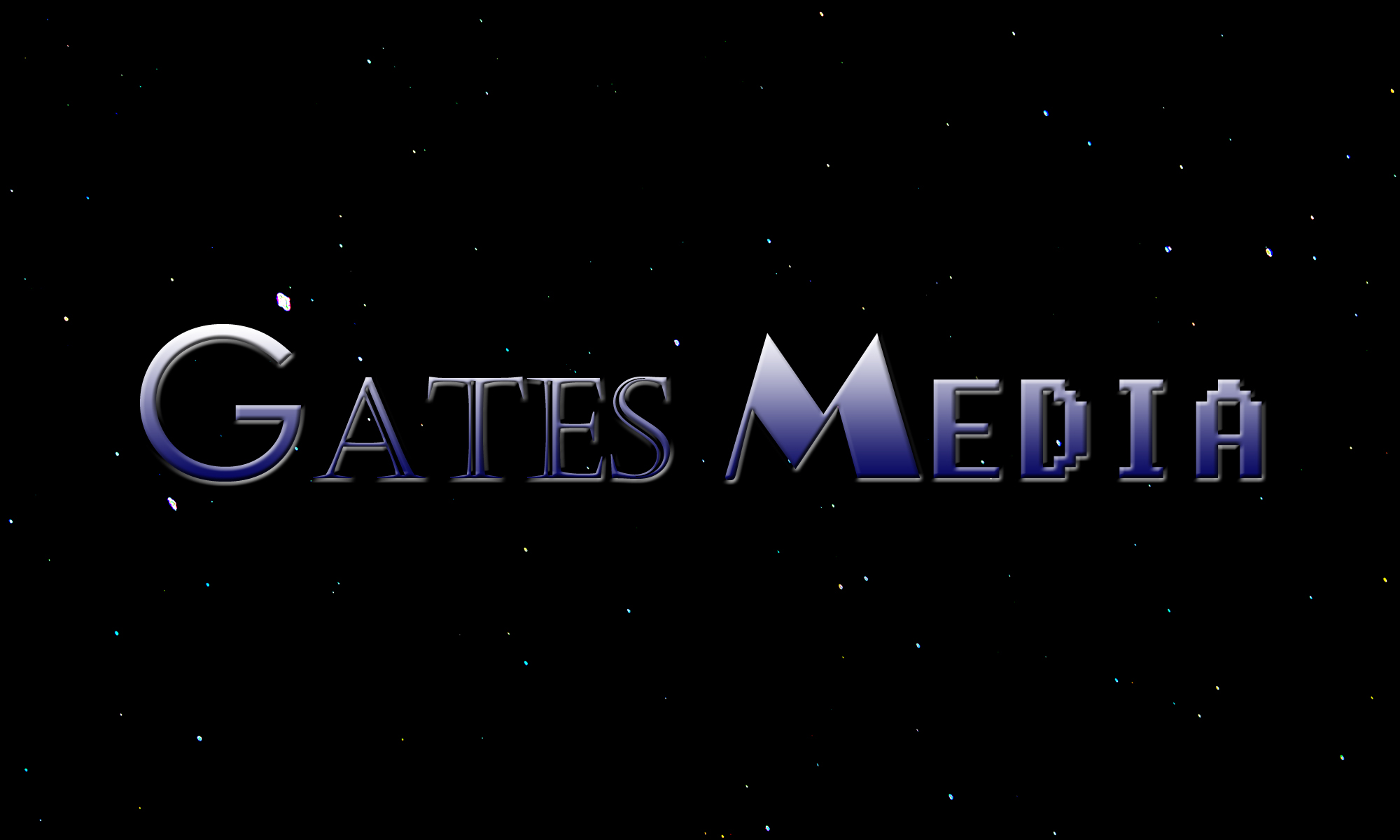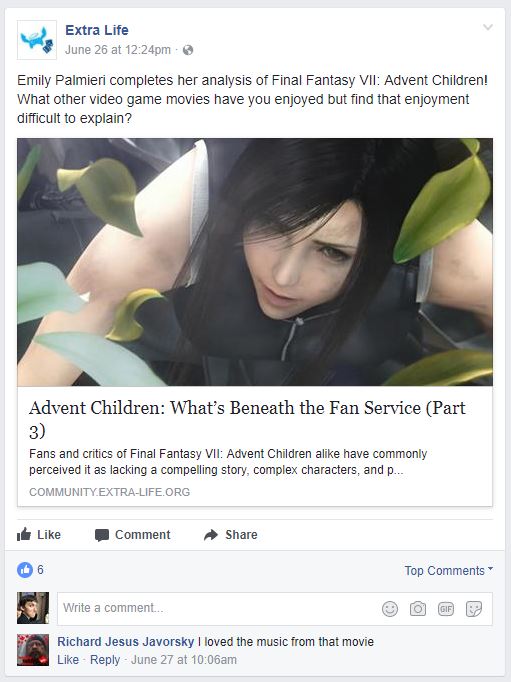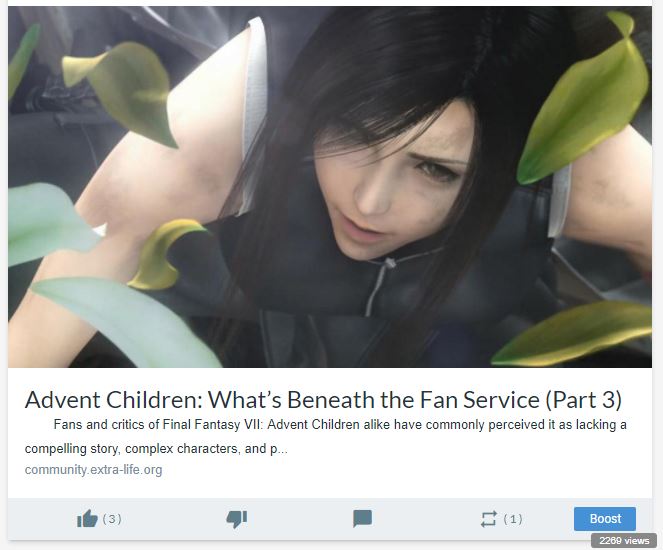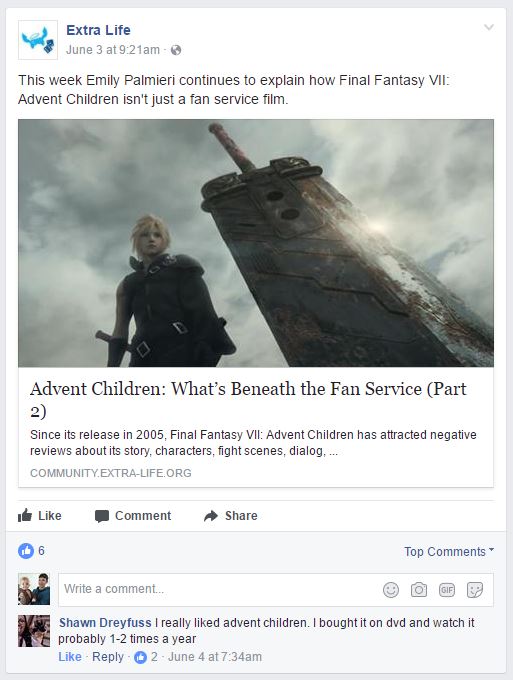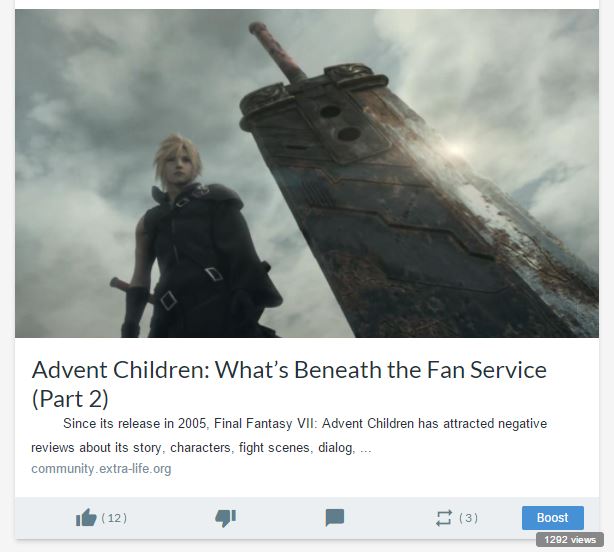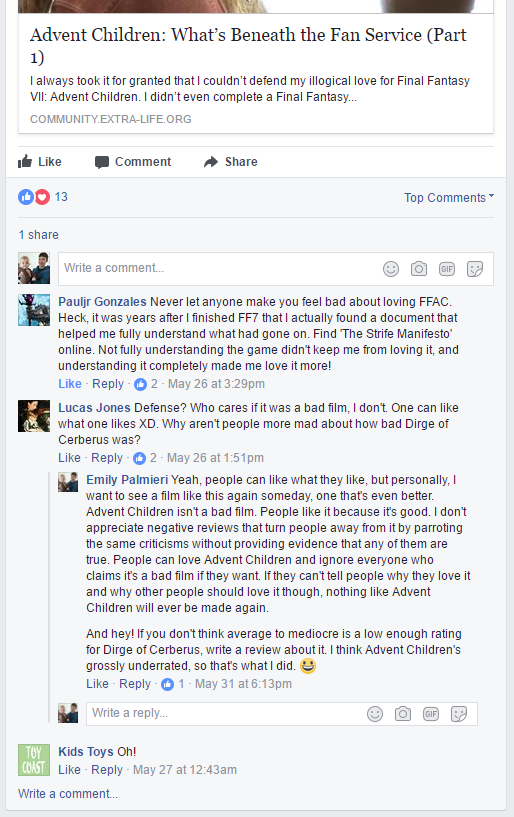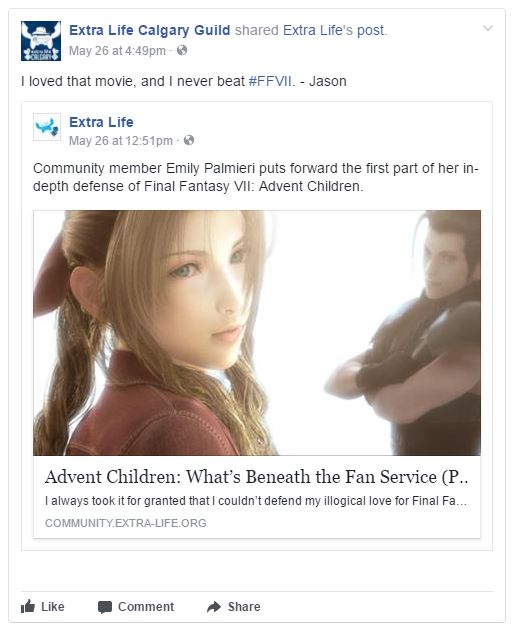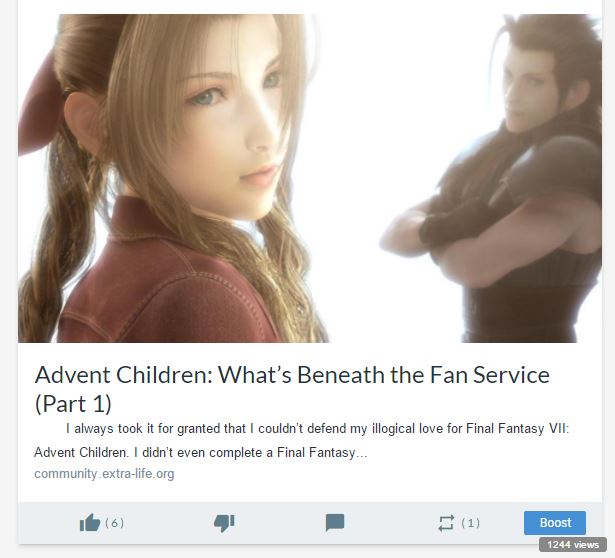The Emoji Movie came out in theaters already… but I’ve received a request to review it. So that’s coming eventually.
Unsolicited Comment: The Definition of “Style Over Substance”
I rediscovered Red Letter Media recently. In one of their recent episodes, Jay defines “style over substance,” something that I assumed I knew what people meant when they said it and never thought to formally define. “Style over substance,” according to Jay, means the way the story is told makes a simple story interesting, or more simply, “style over substance” is filmmaking.
I’ve always thought of “style over substance” meaning purposeless action scenes that mean nothing to the characters, films with artistic styles that detract from or don’t compliment the story, or films that look cool but don’t have a thoughtful take-away message. It’s a phrase I’ve fought against a lot recently in my defense of Final Fantasy VII: Advent Children, which is accused of being all these things. Jay’s definition just gave me a different way to look at the phrase.
Essentially, when people use “style over substance” with Jay’s definition, they’re saying a story is so simple that the way it’s told is the only reason it’s interesting. Probably any story out there, however, could be condensed into a single sentence and claimed to be simple. “A boy becomes a man,” “a man rediscovers his identity,” “a girl embraces her destiny”: these are all stories that could be horribly boring or enthralling, depending on the world and characters it’s told with and the skill of the author(s). The way any story is told is exactly what makes it interesting in any storytelling medium. “Style over substance” is storytelling.
What I’m saying is, if you’ve ever used this phrase in this context with Advent Children… you’re an idiot. 😛
Kingsglaive vs Advent Children: The Consequence of Pointless Action
Transcript:
Kingsglaive: Final Fantasy XV and Final Fantasy VII: Advent Children feature epic battles with giant monsters, magic, high-flying sword fights, high-speed vehicle chases, and overall ridiculous levels of action. Are they really comparable films though? I’ve pointed out in previous videos that these movies have big differences from one another in terms of how they communicate information visually. As action movies, Kingsglaive and Advent Children make their action scenes a spectacle, but what separates a bad action movie from a good one is how well they communicate why each battle matters in addition to making them look awesome. How well do Kingsglaive and Advent Children show the characters’ locations, goals, and thoughts during a fight? Let’s compare the final third of Kingsglaive to three scenes it resembles from Advent Children.
The final third of Kingsglaive features the protagonist Nyx fighting the antagonist General Glauca, the enemy empire Niflheim’s daemons fighting other monsters, Nyx’s friends Libertus and Princess Luna escaping the city of Insomnia, and a parallel scene featuring Niflheim’s chancellor and emperor. The monsters the daemons fight are referred to as the Old Wall, brought to life as a last resort to defend the kingdom of Lucis from its enemies. In the process, they destroy Lucis’ capital Insomnia. Don’t worry. Lucis’ future doesn’t depend on its citizens’ survival. What kind of kingdom needs people?
Libertus and Luna escaping from the city has similarities to the final motorcycle chase in Advent Children. In Kingsglaive, Libertus must escort Luna out of the city so she can deliver a magical ring to Prince Noctis to save Lucis’ future. Their escape is actually pretty uneventful compared to everything else going on in this section of the movie, which is odd considering that Luna and the ring are the only things that matter in it. General Glauca breaks off from his fight with Nyx once to try to stop them, but when a section of missing highway dislodges him, he returns to killing Nyx rather than continuing his pursuit of the most important items in the movie.
In Advent Children’s motorcycle chase, the protagonist Cloud must stop the antagonist Kadaj from using Jenova’s cells to reincarnate Cloud’s greatest enemy Sephiroth. Kadaj also has a mostly carefree escape, but that’s because his brothers forcefully separate Cloud from him. This whole scene is about Cloud fighting through Loz and Yazoo to get to Kadaj rather than two guys just killing each other because they forgot their purpose for fighting.
Actually, Nyx and Glauca do have a reason to fight, but it’s not what you think. Glauca says that he wants the ring, but he and Nyx move ever farther away from it, which suggests he has another goal. This final battle actually symbolizes an ethical debate. Is it better to surrender to your enemy to save the people who haven’t died yet, or should you continue fighting for what you believe no matter the consequences? Glauca wants Lucis to surrender to Niflheim to end the war while Nyx believes that Niflheim could never rule a just future. Neither of them are wrong. Both choices are awful, and either choice could lead to a terrible future.
Let’s not kid ourselves. Nyx and Glauca are equally terrible people, considering how little they care about the wanton destruction and death surrounding them, and Lucis is just as bad as Niflheim. Lucis’ King Regis hoards his son and magical objects behind a wall while forcing his people to fight a losing war to protect them. The final scenes show this blatantly; his own magic kills his own people. Meanwhile, Niflheim murders thousands of civilians whenever it has the chance.
In essence, Nyx and Glauca kill each other simply because they have different beliefs. That’s right! If someone doesn’t believe what you do, just kill them.
This battle mirrors the battle between Cloud and Sephiroth in Advent Children. (Kingsglaive, you can’t just use Advent Children physics without setting them up first!) Among their differences though, the characters have clear motivations, and we can even sympathize with one of them. [“What I want Cloud is to sail the darkness of the cosmos with this planet as my vessel.”] Cloud must save the planet. Simple! Done! Now we can watch the fight without wondering why we should care about two people murdering one another while a city and its inhabitance falls into ruin around them.
Actually, no one in this scene dies. If Cloud fails, everyone on the planet will likely die, but the battle takes place in an abandoned city. Cloud doesn’t even kill Sephiroth in the end. [“I will never be a memory.”] And when Kadaj reappears, Cloud shows him sympathy. He isn’t some psychopath who can murder his colleagues while ignoring the deaths of thousands around him. He can barely handle his memories of two friends who died years ago. Advent Children doesn’t present morally gray questions to mull over, but personally, I prefer its message, “choose life,” to Kingsglaive’s morally reprehensible message, “Kill everyone who disagrees with you and also your allies.”
Finally, most of Nyx and Glauca’s battle takes place on top of a giant monster battle similar to a scene in Advent Children where Cloud and his friends fight the monster Bahamut. The problem with Kingsglaive is that the monsters only add to the visual chaos on screen. Some of the monsters of the Old Wall look and sound like General Glauca. [“Rawr!”] [“Argh! Ugh!”] The monsters on both sides destroy so much with little to no reaction from any of the characters that it all seems pointless.
Additionally, Nyx and Glauca’s battle takes place on constantly moving settings: fighting monsters, collapsing buildings, flying airships, falling debris, and racing cars. They can also teleport anywhere within throwing distance at any time. Kingsglaive seems to think that because of this, it doesn’t have to show how the characters move from one area to the next. Nyx and Glauca can just appear on top of giant monsters or airships whenever it looks cool.
The movie, however, often has to cut to other useless scenes just so that moving Nyx and Glauca from one place to the next makes some kind of sense. The characters can’t jump from a collapsing parking garage and reappear falling from an office building roof, so let’s see what’s going on with Libertus and Luna. [“That’s not something you see every day.”] Nothing. Great. Why are these guys still here? Didn’t they say half an hour ago that they were leaving? Why do we need to hear this information again?
The battle with Bahamut also contains many fighters, some of which fight on top of the monster. The difference from Kingsglaive is that Advent Children constantly shows the location of the fighters, including the monster, in the scene and in relation to one another. The battle takes place in one area that all looks very similar but has landmarks that even serve as an element of combat. In the middle of the battle, we briefly cut away to a scene where Kadaj discovers the location of Jenova’s cells. This scene, however, exists to break up the action and reveal new information rather than to move all the characters to new locations. When we return, the fight picks up right where it left off.
Attacks from the monster also mean something to the characters, especially considering that they’re fighting to save themselves and the city. Not only do we know the characters’ locations, but also, we know their feelings through reaction shots.
Overall, Advent Children’s fight scenes show everything we need to know in an awesome way while Kingsglaive occasionally displays awesome moments in otherwise visually chaotic settings. Both films may appear to be incoherent action fests, but their similarities are only superficial. Beneath the surface, Advent Children uses visual language so masterfully that I find it shocking Square Enix went on to make Kingsglaive, a film so inept that it can barely get across that someone is stealing a crystal without multiple characters verbally pointing it out. Comparing Advent Children to Kingsglaive is like comparing Toy Story to Foodfight!, but if you still don’t believe me, go watch them. Watch them back to back. Then, come back and tell me what you think. Talk at you next time.
[“Shall we take our leave then? The sun will soon set. We need not be here to witness the terrors of the night.”] [“I will return to Niflheim.” “So soon?”]
Advent Children: What’s Beneath the Fan Service (Part 3) Response
Ultramarines: A Warhammer 40,000 Movie
I was looking at a list of movies “like Final Fantasy VII: Advent Children” on IMDB when I found this:
IMDB says it’s rated R, but I don’t quite believe it. NR is more likely with these video game spinoffs. For now, I put it under “R” in the Atypical CGI movie list, but I might move it when I find out for sure. Appleseed was rated R just because someone murdered a child in it I think, so R could still be correct.
Advent Children: What’s Beneath the Fan Service (Part 3)
Hello once again, Final Fantasy VII: Advent Children fans! Have you ever read a review of Advent Children and wondered if the author actually watched the movie? How about listening to reviewers parrot common criticisms about the film only to finish by saying that they love it? How can this film be so amazing and so unique and still receive dominantly negative reviews claiming that it is everything it is not?
Advent Children: What’s Beneath the Fan Service is a three-part series in which I debunk common misconceptions about what is arguably one of the most important CGI movies ever made. Part 1 analyzed Advent Children’s story, characters, and themes. Part 2 discussed how the film tells its story through action. Now, part 3 speculates why Advent Children is so misunderstood and argues its importance in filmmaking history. You can find it here.
Thank you so much for reading. I hope this glimpse beneath the fan service gives you the courage to tell people why you love this movie and why they should love it, too. What does Advent Children mean to you?
I’d like to thank Jack Gardner and Extra Life for supporting this series. For those of you who don’t know, Extra Life is like a marathon for charity, but instead of running or walking, you play video games to raise money for a Children’s Miracle Network Hospital of your choice. The official Extra Life event happens November 4 this year, but you can raise money whenever you want year round. Check out the Extra Life website to learn more, donate, and sign up!
Kingsglaive vs Advent Children: Where Nonsense Originates
Transcript:
Kingsglaive: Final Fantasy XV and Final Fantasy VII: Advent Children get compared a lot. They both contain extravagant action scenes, were created by Square Enix, and are based on games in the Final Fantasy franchise. Both also receive criticism for having convoluted and confusing plots. But how justified is this comparison? In a previous video, I talked about how Kingsglaive’s visuals contradict its audio and its general visual chaos. Is that all that makes its story incoherent? Does Advent Children have the same problem with visual communication? Let’s compare three aspects of their stories to find out.
Both films feature protagonists with inner conflicts that they must confront. Nyx in Kingsglaive deals with the deaths of his mother and sister and his status as an immigrant… supposedly. The film shows the source of Nyx’s torment through a poster board in his room, which has photos of his family and characters likely drawn by his sister. Nyx also watches a cartoon on TV that features the same characters. Nyx, however, looks at these things with indifference… or maybe rage. Is he tormented, or is he just eating something? Stop changing the camera angle every two seconds!
He seems to have a fear that his past will lead to his death. Maybe? What prompted him to think this thought? He’s just sitting on the steps, and then, some guy falls out of the sky and vomits. Nyx hears his sister’s voice throughout the film, but these memories only cause mild inconveniences.
Similarly, guards only occasionally taunt his immigration status. The rest of the time he just plows through them. [“Hey, hey, hey, hey, hey, hey! Wait a minute! Stop!”] Despite the suggestion that he must overcome these problems, we don’t ever know why they’re problematic… except when he decides Princess Luna needs to know about his sister mid-chase scene.
In contrast, Cloud’s inner torment in Advent Children is clearly a problem that he must solve if he expects to survive the film. Cloud deals with the deaths of his friends Zack and Aerith and his affliction with an incurable disease called geostigma. He experiences intrusive visions from his past at inopportune times. He pushes his surviving friends away out of guilt. He feels pain and bleeds blue ink from geostigma. Cloud’s battle against his inner demons makes it difficult for him to fight the enemies resurrected from his past in reality. His inner problems integrate so well with his external struggles that battling his enemies and reuniting with his friends is synonymous with letting go of his past and finding his place in the present.
Kingsglaive and Advent Children also have bad guys that must obtain something important to fulfill their evil plans. In Kingsglaive, the empire Niflheim wants to steal the kingdom of Lucis’ Crystal, which it uses to defend its capital city Insomnia with a magical wall; obtain a magical ring from Lucis’ King Regis; kill and/or kidnap Lucis’ ally Princess Luna; and/or kill King Regis. If that previous semblance of a sentence didn’t clue you in, Kingsglaive doesn’t explain why Niflheim or Lucis care about any of these goals. Let’s look specifically at the Crystal, which at first glance appears to be the most powerful object in the movie. The Crystal is so important in fact that it’s the first thing that we see in the film.
Unfortunately, the scenes during which Niflheim steals it are so chaotic that they render its importance questionable at best. During a distraction peace treaty, Niflheim’s troops enter a smoky room outside the Crystal’s hold. [“The Crystal! They’re after the Crystal!”] The troops break into a room with a control board and a vault door leading to the Crystal. They blow up the control panel, which causes Insomnia’s wall to fall. [“The wall, it’s gone.”] Later, Niflheim’s chancellor and emperor watch one of their ships carry the Crystal away.
It sounds straightforward… until you mix it with King Regis’ battle against robots and a menacing suit of armor and Nyx’s fight with traitorous teammates and a giant octopus. Additionally, the Crystal doesn’t look like a crystal, and this movie doesn’t like to hold any of its shaky and poorly chosen shots for more than two seconds. There’s a reason why the characters narrate this entire heist. “They broke into a room with a… panel? Where’s the Crystal?” “What is this black thing covered in smoke?” [“The Crystal!”] “Oh, you mean this window divider is the Crystal?”
The aftermath doesn’t stress the importance of this event either. No one cares. Nyx and Luna point out that the wall has fallen before they return to killing traitors. The ambassador and the emperor of Niflheim talk about what happens next. “The Crystal…! Well, let’s go see if King Regis is still alive.” With the editing and cinematography, stealing the Crystal has as much weight as saving Luna from octopods and King Regis fighting for his life. In the end, do any of them matter? The Crystal’s gone. Regis dies. Luna throws herself out of an airship and yet is entrusted with a magic ring that no one can wear.
Advent Children’s antagonist Kadaj wishes to find the remnants of Jenova, an alien being that caused a catastrophe long ago. When Kadaj discovers the alien matter hidden in plain view, the film highlights its importance by making an event out of it. The possessor, Rufus, and Kadaj attract the attention of almost every major member of the cast when Rufus tosses Jenova’s remains off a building, and he and Kadaj jump after them in slow motion. Kadaj tries to grab the box out of the air while Rufus shoots at it.
This scene occurs between two fight scenes, but they all feel very different, which makes it stand out. This scene features a desperate few seconds dragged out into almost a minute. The previous scene shows Cloud rediscovering friendship power, and the next has a high-speed motorcycle battle. While we don’t know until the end of the movie what Kadaj will do with Jenova, the dramatic visuals in this scene foreshadow the importance of him obtaining it.
Finally, the protagonists in both films must follow the clues to reach their goals and solve problems. Nyx tends to just know things for no reason. [“Your hairpin. They’re tracking it. Give it to me.”] [“Pelna, get out of there! It’s a trap!”] At one point, Nyx discovers a pattern on an enemy monster and somehow makes the connection that it’s attracted to a hairpin that Luna wears despite neither of them bearing any resemblance to one another. Similarly, he somehow determines that a trap octopus monster is onboard an airship in response to his teammate observing enemy guards. These are relatively minor problems in comparison to Nyx’s unexplained faith that a suicidal woman, a ring that kills everyone who wears it, and an absent prince have more importance to the future that he wants to save than an entire city of people who might have lived in it.
In contrast, the characters in Advent Children know surprisingly little about anything. [“So what’s going to happen now?”] [“Where’s Mother?”] [“Kadaj, what is he?”] [“Who’s that?”] [“What’s this stuff about Mother?”] [“What do you mean?”] Cloud seems clueless as to how Kadaj will reincarnate Sephiroth right up until Kadaj shoves Jenova cells in his chest. He doesn’t know the cure for geostigma until he’s cured. He doesn’t even seem know what happens at the end of the movie. [“It’s like she said: ‘Wait here and Cloud will come back.'” …] The film provides visual clues for the audience to interpret what happened, but the characters don’t usually do this themselves, at least not audibly.
This final point sums up what Advent Children and Kingsglaive do that makes their stories confusing to follow. They depict two visual storytelling extremes. Advent Children shows all its clues but rarely interprets what they mean audibly while Kingsglaive states what difficult to decipher and non-existent visual clues mean even when that interpretation doesn’t make sense. I’ll let you decide if a blank stare is a preferable explanation to: [“Your hairpin. They’re tracking it. Give it to me.”]
So how do their fight scenes compare? That’s a subject for another video. Talk at you next time.
[“A man’s past is his pride.” “No, my pride is shaping the future.”]
Advent Children: What’s Beneath the Fan Service (Part 2) Response
Advent Children: What’s Beneath the Fan Service (Part 1) Response
Advent Children: What’s Beneath the Fan Service (Part 1)
You can find The Strife Manifesto here. It’s an interesting analysis of Cloud’s character in the game.
Advent Children: What’s Beneath the Fan Service (Part 2)
Hello again, Final Fantasy VII: Advent Children fans! Have you ever wondered what makes Advent Children’s high-speed motorcycle battles, giant swords, and physics-defying action awesome? What does this movie do that other action movies don’t? Would you believe that Loz throwing a motorcycle with his feet, friendship defeating Bahamut, and a gunshot wound threatening to kill Cloud all follow a consistent set of rules?
Advent Children: What’s Beneath the Fan Service is a three-part series in which I debunk common misconceptions about what is arguably one of the most important CGI movies ever made. Part 2, now up on the Extra Life Community website, discusses how Advent Children tells its story and defines its world through action, visual language, and efficient dialog. You can find it here. If you missed part 1, which analyzes the story Advent Children tells, you can read that here.
Feel free to spread this around! If you want more movies like Advent Children, don’t be afraid to tell people why you love it and why they should love it, too. Everyone needs to know what’s beneath the fan service.
For those of you who don’t know, Extra Life is like a marathon for charity, but instead of running or walking, you play video games to raise money for a Children’s Miracle Network Hospital of your choice. The official Extra Life event happens November 4 this year, but you can raise money whenever you want year round. Check out the Extra Life website to learn more, donate, and sign up!
